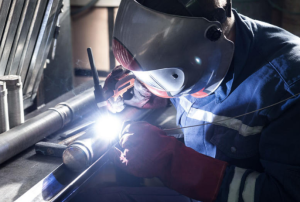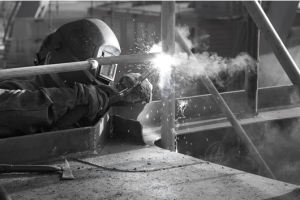Not all MIG welders can use gasless wire; check for flux-cored capability and DCEN polarity switching in the welder’s specifications.
How to Determine if Your MIG Welder Can Use Gasless Wire
To identify whether your MIG welder can accommodate gasless wire, the first step is to reference your welder’s manual or the specification sheet provided by the manufacturer. Look for the type of wire feed system it can accommodate and how many volts it can carry. MIG welders that can accommodate flux cored, gasless wire will often specify this, such as a welder running on 110-140 volts is likely meant for a smaller diameter of wire, of which many gasless wires are used for a light fabrication and hobby welding. If your welder cannot handle smaller diameter gasless wires, which run through flux-cored wire feed, then it will not accommodate gasless wire.
Another concern is the wire feed settings and polarity. Gasles MIG welding requires a specific wire feed, meaning your MIG welder must be adjustable to allow for different requirements as flux-cored wires are used in. As for the polarity, gasless MIG weldings require direct current electrode negative to flow through. This will be particularly useful if your welder can switch polarities.
Subsequently, consider the wire feeder rolls on your MIG welder. The size of the rollers needs to match the diameter of the gasless wire you are using, keeping in mind that the most common sizes are 0.030 and 0.35 inches. The size of the rollers must match as this will impact the wire feed and, subsequently, the malfunction of the welder. By extension, then, this will also affect the overall performance of the weld . Finally, understand the performance through the thermal overload system. Gasless welding, while cheaper than regular welding, is more taxing on the welder. Subsequently, having a robust thermal overload system that runs a duty cycle of about 20% at 90 amps will ensure your machine can handle the continuous flux-cored welding. Another concern is the availability of resources and whether you can get parts easily and call for support, especially if this is your first time welding gasless. Call the manufacturer to see if they have the resource you will need.
Types of Gasless Wires Available
Exploring E71T-GS Wires
Among the most common types of gasless wires is E71T-GS. Single-pass flux-cored gasless wire is specifically utilized for thin steel applications, including the materials with a thickness of up to 3/16 inches . Notably, E71T-GS wires do not need any external shielding gas. This fact allows them to be perfectly used in outdoor welding as there is no wind involved . These wires produce a very smooth arc with just a little spatter and a pleasant bead appearance. They can be used even by the beginners or the welders who work with light repair projects, as the overall tensile strength reaches no more than 70,000 psi, which is rather sufficient for most light-duty work.
Explaining E71T-11 Wires
As for E71T-11 wires, they are available in a multifunctional version that is recommended for all-position welding, which is not always appropriate for E71T-GS. These wires can also be used for multiple pass applications, and they provide strong welds when it comes to welding thicker materials . Additionally, they are compatible with low to medium power settings that make it possible to use this type of wire in a wider range of machines and projects. There are no specific data on the cost of E71T-11, but usually, this type of wires is about 5 to 10% pricier than E71T-GS wires. The overall tensile strength of E71T-11 wires can be up to 71,000 psi. Overall, E71T-11 appears to be a more versatile version of a flux-cored gasless wire in comparison to the abovementioned.
Comparison and Performance
The main discrepancy between these two types of gasless wires is the fact that E71T-11 wires are more versatile in terms of their usage, as well as diverse in terms of the materials they can be used for. E71T-GS is probably cheaper as it can provide only the single-pass function with some thinner materials. At the same time, despite the dubious cost of E71T-11, it is more frequently used by welders, who have a thicker metal for welding.
Setting Up Your MIG Welder for Gasless Welding
The first recommendation for setting up your MIG welder for gasless welding procedure is adjusting the polarity. In the case of gasless flux-cored welding, a direct current electrode negative configuration is required . The suitable setting ensures effective electric current flowing through the wire to the welding surface, which is essential for forming strong and deeply-penetrating weld joints. In this case, the revers lead connections at the terminals are vital. To develop them, attach the ground clamp to the positive terminal and the welding gun to the negative one.
The next set of recommendations is related to the selection of the appropriate wire and the drive roll. The thickness of the selected gasless wire depends on the quality of the performed project, so one should select the suitable material. The thinner E71T-GS wire is suitable for light materials, such as sheet metal. The E71T-11 type is applicable to all-position welding. Furthermore, I recommend selecting materials of a 0.030-inch diameter for performing the majority of household repair and lightweight fabrication work. Concerning the drive roll, it should match the size of the wire. In this case, a knurled driver roll variant is suitable because the flux-cored welding wire is softer and slips more if a smooth drive roll is used.
Lastly, I believe that wire feed speed and voltage settings are paramount for ensuring proper flux-cored welding . Its adjustment depends on the specifications of the wire and the thickness of the material. For instance, a 0.030-inch wire variant is normally adjusted at the speed of approx. 110 inches per minute in case of welding 1/8-inch steel. The proper voltage settings are 18 to 22 volts. The selection of the suitable parameters may significantly influence a lack of proper penetration capability in the weld joint. As a result, start the voltage at a higher level and slowly lower it, monitoring your wire feed speed. Time your adjustments to keep pace with your welding speed and invest time in the preparation before performing the welding work.

Compatibility of MIG Welders with Gasless Wire
How to Find a MIG Welder Suitable for Gasless Wire
-
Verify the support for flux-cored welding: Using a multi-process welder that supports flux-cored or FCAW welding is the easiest way to determine gasless wire compatibility. Look for the presence of “flux-cored welding” or “FCAW” terminologies in the product description or manual since MIG welders that support both gasless and gas welding will likely have adjustments for both solid and flux-cored wires.
-
Ensure that the welder can switch polarity: Select a welder that can effectively handle gasless welding by confirming that there is an option to switch the required polarity. Gasless welding needs DCEN or Direct Current Electrode Negative polarity. Always double-check the ability to switch polarity between DCEP and DCEN-like options. This is important, as the polarity of a welding arc can influence how a weld bead penetrates the base metal and whether the weld will remain stable.
-
Check the compatibility of the wire feed mechanism: The type of wire feed mechanism can also influence the compatibility of gasless wire use. Gasless wire is usually softer than solid wire, and high-quality welders for gasless wire have a strong drive system and adjustable tension control. This helps avoid crushing, kinking, and tangling of the wires during the feeding process. Since feeding the wire is difficult, always look for knurled rollers since they perform better in terms of wire grip.
-
Inspect the power and voltage requirements: Determine the welder’s power by checking its specifications and how it fits into the requirements of welding gasless wire. Gasless wire commonly reacts well with specific power ranges. For example, a 0.035-inch FCAW wire requires between 160 and 195 amperes or even more, depending on the thickness of the material to weld and the position in which it is welded. Further considerations should also include an easy-to-configure voltage control and feed speed.





